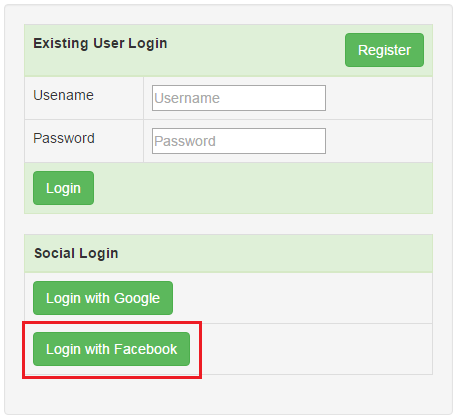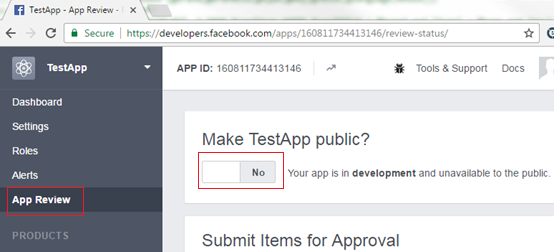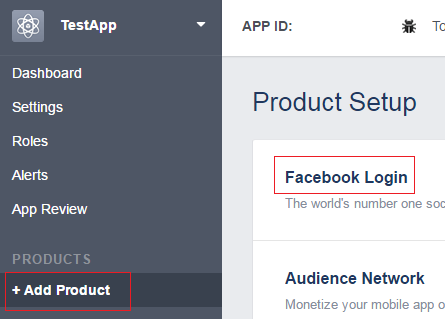Suggested Videos
Part 26 - ASP.NET Web API logout
Part 27 - How to get authenticated user identity name in asp.net web api
Part 28 - ASP.NET Web API google authentication
In this video we will discuss using Facebook authentication with ASP.NET Web API. This is continuation to Part 28. Please watch Part 28 from ASP.NET Web API tutorial before proceeding.

When the user clicks "Login with Facebook" button, he will be redirected to Facebook login page. The user will then provide his Facebook credentials. Once the login is successful, the user will be redirected to our application with an access token, which is a proof that the user is successfully authenticated and our web application grants access to the protected resources.
To use Facebook account for authentication, we will have to first register our application with Facebook. Here are the steps to register your application with Facebook. Once we successfully register our application, we will be given a Client ID and Client Secret. We need both of these for using Facebook authentication with our Web API service.
Step 1 : To register your application go to
https://developers.facebook.com/
Step 2 : Login with your Facebook account.

Step 3 : Next we need to make the App that we just created public. To make the App, public, Click on "App Review" menu item on the left and then click the Yes|No button.

Step 4 : Next we need to add "Facebook Login" product to our App. To do this click "Add Product" menu item on the left and click "Get Started" button against "Facebook Login"

Step 5 : In "Valid OAuth redirect URIs" textbox, include the URI of your application. I have my web api application running at http://localhost:61358
In the same textbox we also need to include the redirect URI i.e the path in our application that users are redirected to after they have authenticated with Facebook. I have set it to http://localhost:61358/signin-facebook

Click "Save Changes"
Step 6 : Click "Dashboard" menu item on the left and you will see App ID and App Secret.
Enable Facebook OAuth authentication in ASP.NET Web API service
Step 1 : Facebook has made a breaking change to it's API in version 2.4. The change is, in addition to the access token we also have to send the fields that we want in URI. In version 2.3 and earlier, the URI used to be as shown below. The access token is appended to the URI using a ?
https://graph.facebook.com/v2.3/me?access_token=ABC
With version 2.4, they have changed it to as shown below. Instead of using ? we have to use & to attach the access token to the URI
https://graph.facebook.com/v2.4/me?fields=id,email&access_token=ABC
The defualt implementation for the Facebook Client, that is provided by Microsoft attaches the access token to the URI using a ?, so we have to change it to &. To do that,
Step 2 : In Startup.Auth.cs file in App_Start folder include the following code block. Use the AppID and AppSecret that we got after registering our application with Facebook.
Step 3 : On Login.html page, include the HTML for "Login with Facebook" button.
Step 4 : Wire up the click event handler for "Login with Facebook" button
Step 5 : In GoogleAuthentication.js file, modify isUserRegistered() and signupExternalUser() functions as shown below. I have included comments where the code is modified, so you know what has changed.

Part 26 - ASP.NET Web API logout
Part 27 - How to get authenticated user identity name in asp.net web api
Part 28 - ASP.NET Web API google authentication
In this video we will discuss using Facebook authentication with ASP.NET Web API. This is continuation to Part 28. Please watch Part 28 from ASP.NET Web API tutorial before proceeding.

When the user clicks "Login with Facebook" button, he will be redirected to Facebook login page. The user will then provide his Facebook credentials. Once the login is successful, the user will be redirected to our application with an access token, which is a proof that the user is successfully authenticated and our web application grants access to the protected resources.
To use Facebook account for authentication, we will have to first register our application with Facebook. Here are the steps to register your application with Facebook. Once we successfully register our application, we will be given a Client ID and Client Secret. We need both of these for using Facebook authentication with our Web API service.
Step 1 : To register your application go to
https://developers.facebook.com/
Step 2 : Login with your Facebook account.
- Click "Create App" button
- Provide a name for the App in the "Display Name" textbox. I named it TestApp
- Provide yor email in the "Contact Email" textbox
- Select a Category. I selected "Education"
- Finally, click "Create App ID" button

Step 3 : Next we need to make the App that we just created public. To make the App, public, Click on "App Review" menu item on the left and then click the Yes|No button.

Step 4 : Next we need to add "Facebook Login" product to our App. To do this click "Add Product" menu item on the left and click "Get Started" button against "Facebook Login"

Step 5 : In "Valid OAuth redirect URIs" textbox, include the URI of your application. I have my web api application running at http://localhost:61358
In the same textbox we also need to include the redirect URI i.e the path in our application that users are redirected to after they have authenticated with Facebook. I have set it to http://localhost:61358/signin-facebook

Click "Save Changes"
Step 6 : Click "Dashboard" menu item on the left and you will see App ID and App Secret.
Enable Facebook OAuth authentication in ASP.NET Web API service
Step 1 : Facebook has made a breaking change to it's API in version 2.4. The change is, in addition to the access token we also have to send the fields that we want in URI. In version 2.3 and earlier, the URI used to be as shown below. The access token is appended to the URI using a ?
https://graph.facebook.com/v2.3/me?access_token=ABC
With version 2.4, they have changed it to as shown below. Instead of using ? we have to use & to attach the access token to the URI
https://graph.facebook.com/v2.4/me?fields=id,email&access_token=ABC
The defualt implementation for the Facebook Client, that is provided by Microsoft attaches the access token to the URI using a ?, so we have to change it to &. To do that,
- Add a folder to the project. Name it "Facebook"
- Add a class file to the folder. Name it FacebookBackChannelHandler.cs
- Copy and paste the following code.
using System;
using System.Net.Http;
using System.Threading;
using System.Threading.Tasks;
namespace EmployeeService.Facebook
{
public class FacebookBackChannelHandler : HttpClientHandler
{
protected override async Task<HttpResponseMessage>
SendAsync(HttpRequestMessage request,
CancellationToken cancellationToken)
{
if
(!request.RequestUri.AbsolutePath.Contains("/oauth"))
{
request.RequestUri = new Uri(
request.RequestUri.AbsoluteUri.Replace("?access_token", "&access_token"));
}
return await base.SendAsync(request,
cancellationToken);
}
}
}
Step 2 : In Startup.Auth.cs file in App_Start folder include the following code block. Use the AppID and AppSecret that we got after registering our application with Facebook.
var facebookOptions = new FacebookAuthenticationOptions()
{
AppId = "160811734413146",
AppSecret = "21f2665e0aed11867fcd8d35e67d6068",
BackchannelHttpHandler = new FacebookBackChannelHandler(),
UserInformationEndpoint = "https://graph.facebook.com/v2.4/me?fields=id,email"
};
facebookOptions.Scope.Add("email");
app.UseFacebookAuthentication(facebookOptions);
Step 3 : On Login.html page, include the HTML for "Login with Facebook" button.
<tr>
<td>
<input type="button" id="btnFacebookLogin"
value="Login with Facebook" class="btn btn-success" />
</td>
</tr>
Step 4 : Wire up the click event handler for "Login with Facebook" button
$('#btnFacebookLogin').click(function () {
window.location.href = "/api/Account/ExternalLogin?provider=Facebook&response_type=token&client_id=self&redirect_uri=http%3a%2f%2flocalhost%3a61358%2fLogin.html&state=GerGr5JlYx4t_KpsK57GFSxVueteyBunu02xJTak5m01";
});
Step 5 : In GoogleAuthentication.js file, modify isUserRegistered() and signupExternalUser() functions as shown below. I have included comments where the code is modified, so you know what has changed.
function isUserRegistered(accessToken) {
$.ajax({
url: '/api/Account/UserInfo',
method: 'GET',
headers: {
'content-type': 'application/json',
'Authorization': 'Bearer '
+ accessToken
},
success: function (response) {
if (response.HasRegistered) {
localStorage.setItem("accessToken", accessToken);
localStorage.setItem("userName", response.Email);
window.location.href = "Data.html";
}
else
{
// Pass the login provider (Facebook or
Google)
signupExternalUser(accessToken,
response.LoginProvider);
}
}
});
}
// Include provider parameter
function signupExternalUser(accessToken, provider) {
$.ajax({
url: '/api/Account/RegisterExternal',
method: 'POST',
headers: {
'content-type': 'application/json',
'Authorization': 'Bearer '
+ accessToken
},
success: function () {
// Use the provider parameter value
instead of
// hardcoding the provider name
window.location.href = "/api/Account/ExternalLogin?provider=" + provider + "&response_type=token&client_id=self&redirect_uri=http%3a%2f%2flocalhost%3a61358%2fLogin.html&state=GerGr5JlYx4t_KpsK57GFSxVueteyBunu02xJTak5m01";
}
});
}

The facebook ExternalLogin is returning "error=access_denied" could you please help?
ReplyDeleteUpdate all nuget packages
DeleteInstall-Package Microsoft.Owin.Security.Facebook -Version 4.0.1
DeleteUpgrading the nuget package does not solve this problem and the above code does not include a definition for SendAsync
DeleteHi Sir, i am also facing the same issue("error=access_denied"). please help how can i resolve the issue.
ReplyDeleteI was using Microsoft.Owin.Security.Facebook version 3.0.1 from Nuget. Updated it to the prelease version 3.1.0 from Nuget and I no longer got the access denied error.
ReplyDeletep;ease provide the complete source code for the project
ReplyDeleteIn my visualstudio GoogleAuthentication.js file not avaliable how to download GoogleAuthentication.js file in my sloution explorer
ReplyDeleteyou don't need to bro just make one.
DeleteHello,
ReplyDeleteI get "error=access_denied" for the face book authentication. Appreciate any help
Thanks
Hi,
Deletedid you by any means solve this issue? Has been bugging me for some days now.
No one has asked this but how to tackle the error 'Email Already Taken' we get when fb and Google account use the same email id.
ReplyDeleteHey Venkat,
ReplyDeleteI'm assuming you didn't give a demo of Twitter Authentication because Twitter oAuth doesn't return email address of the user.
I have read couple of stackoverflow posts, tried couple of other things but all in vain.
By any chance, were you able to implement Twitter login?
I could use a dummy email for twitter login but that would just be an hack not a solution.
Thanks
Gauri Shankar Badola
Hello Venkat ! I hope you are well, I am trying to do the login with google and facebook, and in my project, despite I have add all the nuget package required, it seems that I don't have any Startup.Auth.cs file in app_Start. how can I get it ? is it something that is supposed to be created automatically or not ?
ReplyDeletefacebook apps now require privacy policy URL to make the app Public...can't find
ReplyDeleteHello,
ReplyDeletei have encountered a strange error im not quite sure how to solve. I get redirected to Facebook for the authentication but, as soon as i confirm it, i get a strange error at the uri part:'#error=access_denied'. I don't know if i have to update the split function for the token or is it a database problem? Please help, im very confused how to procced.
Dear Sir,
ReplyDeleteI tried follow this sample, but after login with facebook then does not contain access_token field. Although, I can read access_token when FacebookBackChannelHandler.SendAsync
Hi,
ReplyDeletei'm getting the following error. can you please tell me the issue
Resource not found. "/api/Account/ExternalLogin"